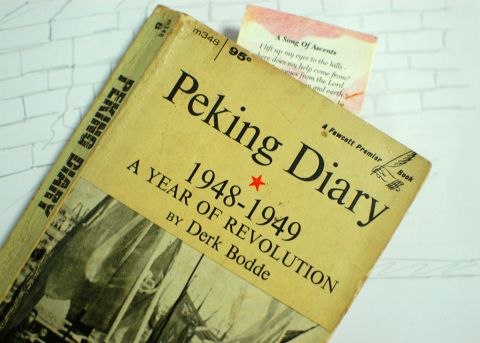
Peking Diary: (1948 – 1949) A Year of Revolution is a compilation of diary notes by Professor Derk Bodde on his stay in Peking (now Beijing) during the tumultuous year that culminated in the formation of the People’s Republic of China. Derk was a sinologist, with an expertise in Chinese philosophy, and the first Fulbright Scholar to China. The book draws from his first hand experience of living in the city during the revolution, the people he interacted with and his vast experience of China.
In the early part of the 20th century, Dr. Sun Yat-sen (now called the Father of the Nation in China & Taiwan) and his Kuomintang (KMT) Party created a revolution that overthrew the imperial rule that China had been under for many millennia. Known as the Nationalists, they were later headed by General Chiang Kai-shek during WWII, when China was subjugated and raped by Japan. But, there was also growing discontent due to the corruption and bad governance of the Nationalists. Mao Tse-tung created a Communist force in the rural and mountainous regions that grew on this unhappiness and drew the Nationalists into a civil war. The Nationalists were well funded with money, supplies and weapons by USA. Despite this, the Red Tide from the North grew steadily and reached the vicinity of Peking by 1948, around the time Derk moved there to work on a translation of Chinese works. Peking would fall to the Red Tide in 1949, which would sweep over the entire mainland China and the KMT would retreat to Formosa (now Taiwan).
In the beginning, the Nationalists were confident that they could hold Peking against the Communists. They had come to power on the promise of (land) reform and development, which they never delivered. The Communists fed on the increasing economic disparity, promised a classless society and an end to feudalism in rural areas. As Communist forces massed around Peking, the city went under seige. It became choked with refugees, students and Nationalist soldiers fleeing from the North. With the supply of food dwindling, the regions under the Nationalists experienced hyper-inflation. With massive price fluctuations, hoarding and looting, the Peking general finally gave in to the Communists.
Being able to speak and read Chinese fluently and having lots of native friends, Derk paints a very real picture of how the city changed once the Communists took over. Despite their inexperience with urban management, they brought order, good governance and reined in the economy. Women in particular and the youth in general found empowerment. However, the Communists took complete control of every other sphere of life. Workers of all trades were brought together under unions. The independence of all newspapers and radio was curtailed, and they had to become mouthpieces of the Communist propaganda machine. All religious activities were called as silly superstitions that harmed society and were shut down. Socialist and Marxist subjects were introduced into schools and the textbooks were modified. Secret agents and information boxes were introduced to weed out the people who opposed the Communists.
Not only does the book give a clear picture of the Communist revolution, it also answers two big questions. First, was the Chinese Communist revolution a copy of that in Russia (like the USA says it is)? Second, why did Chinese embrace Communism? For the first, Derk shows that though the ideology was from Russia, the movement was wholly created, fed and led by Chinese problems, ideas and culture. Secondly, having experienced years of apathy and corruption under the Nationalists, the Chinese embraced Red, since that was the only strong alternative they saw. The lesser of the two evils, if you may.
With each passing year, my interest in the history and culture of East and South East Asia continues to grow. As I discover more, I see the myriad similarities and the surprising parallels that can be drawn with India. Post-1947 Indian history is replete with socialism and a brush with Communist-style clampdown (the Emergency). Today, economic disparity and corruption continues to grow. Naxalism gains power in tribal and rural areas where the government has looted natural resources. Standing at this crossroad in time, I found Peking Diary to be a fabulous read, both for its first hand view and its historic insights into the Chinese revolution. The book is refreshingly free of the American stereotype of China and the writing is so personal that it cannot be put down.
Rating: 4/4

Interesting book and review 🙂
Pramod: Yeah, it was a fascinating read. Filled so many gaps in my world history. 🙂
Been a while since I read anything about china. Last was Wild swans which was a good read about 3 generations(author, her mother and grandmom) in China right from the early 20th till the 1980s.
This seems like an interesting read. Should check this one out!
Srivaid: I remember about Wild Swans, need to read it sometime. It is highly unlikely that you will come across this book. Its publication itself went through some trouble, since this was during McCarthyism in USA and it has not been reprinted in recent decades. I can give it away to you next time I am home.
OK. Thanks. But do not underestimate Blossoms 🙂